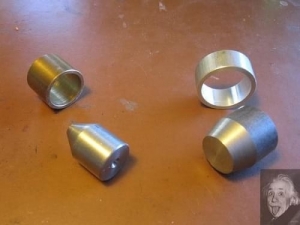Like many HSMs I don't have the headroom on my mill to use a coax indicator to center holes under the quill.
If the job doesn't require the accuracy of the Zero-It indicator, I'll often just use the pointy end of the edge finder (shown at top of picture) to center the hole. Unfortunately, the larger end of the conical tip is only 0.3" diameter so one is out of luck for holes larger than that.
If the holes happen to be aliquot sizes, a set of nesting drill bushings (shown at bottom) can help but, if the hole is slightly over/under size, the fit can be sloppy.
I made these two devices to deal with the problem. Each consists of a slug of steel, accurately center-drilled at one end and having a conical taper at the other. Each has a companion close-fitting ring.
In use, the cone is inserted into the hole and the ring is pressed down on the stock to ensure that the conical plunger is held vertically. Then the cone on the edge finder is inserted into the center-drilled hole.
No, it's not as accurate as using a DTI in the Zero-It but it's more than accurate enough for 90% of the jobs I do.
They're simple to make. Try one.


 LinkBack URL
LinkBack URL About LinkBacks
About LinkBacks





 Reply With Quote
Reply With Quote



Bookmarks